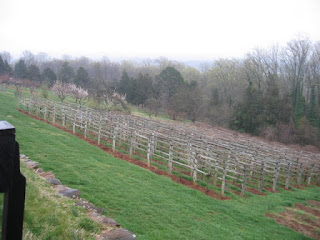One interesting theme to explore at Bennett Place is what native plants might have been used by the Bennetts and others in the 19th century. Growing naturally at the site in sunny areas is Yucca filamentosa. The photo shows native Yucca being cultivated at Thomas Jefferson's Monticello, possibly for the fiber that can be extracted from the leaves.
In the woods at Bennett Place grow low-bush blueberries and wild grape. Currently they are too shaded to bear fruit, but they may well have played a dietary role back when the woodland was more open.
The second photo shows a vineyard at Monticello. The native muscadine grape (Vitis rotundifolia) was widely grown in the States. Wikipedia refers to the scuppernong as being the same species as muscadine, but larger and green.
I once encountered a patch of delicious muscadines next to Ellerbe Creek a mile downstream of Bennett Place, growing like a curtain high and wide on trees next to a service drive near Hillsborough Road and 15-501. The patch was lost during the expansion of I-85, but testifies to the abundant fruit the wild grape can bear.
This third photo, taken at a scout camp in the pinelands of New Jersey, shows an open woodland with an understory of lowbush and highbush blueberries growing in sandy soil. Among the plants this woods and Bennett Place have in common are post oak, white oak, blackjack oak, shortleaf pine, bracken fern and the blueberries. The soil at Bennett Place was described by the soil service as having some sandy elements more typical of areas further east, in the coastal plain. The Bennett Place woodland would look very much like this if the historically open canopy was restored, allowing enough sunlight in for the blueberries to bear fruit.
Tuesday, October 5, 2010
Subscribe to:
Post Comments (Atom)



No comments:
Post a Comment